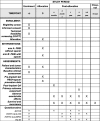A randomized controlled trial testing a hyaluronic acid spacer injection for skin toxicity reduction of brachytherapy accelerated partial breast irradiation (APBI): a study protocol
- PMID: 30558672
- PMCID: PMC6298013
- DOI: 10.1186/s13063-018-3035-3
A randomized controlled trial testing a hyaluronic acid spacer injection for skin toxicity reduction of brachytherapy accelerated partial breast irradiation (APBI): a study protocol
Abstract
Background: Accelerated partial breast irradiation (APBI) is a treatment option for selected early stage breast cancer patients. Some APBI techniques lead to skin toxicity with the skin dose as main risk factor. We hypothesize that a spacer injected between the skin and target volume reduces the skin dose and subsequent toxicity in permanent breast seed implant (PBSI) patients.
Methods: In this parallel-group, single-center, randomized controlled trial, the effect of a subcutaneous spacer injection on skin toxicity among patients treated with PBSI is tested. Eligibility for participation is derived from international guidelines for suitable patients for partial breast radiotherapy, e.g. women aged ≥ 50 years with a histologically proven non-lobular breast carcinoma and/or ductal carcinoma in situ (DCIS), tumor size ≤ 3 cm, node-negative, and PBSI technically feasible. Among exclusion criteria are neoadjuvant chemotherapy, lymphovascular invasion, and allergy for hyaluronic acid. For the patients allocated to receive spacer, after the PBSI procedure, 4-10 cc of biodegradable hyaluronic acid (Barrigel™, Palette Life Sciences, Santa Barbara, CA, USA or Restylane SubQ®, Galderma Benelux, Breda, the Netherlands) is injected directly under the skin using ultrasound guidance to create an extra 0.5-1 cm space between the treatment volume and the skin. The primary outcome is the rate of telangiectasia at two years, blindly assessed using Bentzen's 4-point scale. Secondary outcomes include: local recurrence; disease-free and overall survival rates; adverse events (pain, redness, skin/subcutaneous induration, radiation dermatitis, pigmentation, surgical site infection); skin dose; cosmetic and functional results; and health-related quality of life. A Fisher's exact test will be used to test differences between groups on the primary outcome. Previous studies found 22.4% telangiectasia at two years. We expect the use of a spacer could reduce the occurrence of telangiectasia to 7.7%. A sample size of 230 patients will allow for a 10% lost to follow-up rate.
Discussion: In this study, the effect of a subcutaneous spacer injection on the skin dose, late skin toxicity, and cosmetic outcome is tested in patients treated with PBSI in the setting of breast-conserving therapy. Our results will be relevant for most forms of breast brachytherapy as well as robotic radiosurgery, as skin spacers could protect the skin with these other techniques.
Trial registration: Netherlands Trial Register, NTR6549 . Registered on 27 June 2017.
Keywords: Brachytherapy; Breast neoplasms; Hyaluronic acid; Partial breast irradiation; Permanent breast seeds implant; Skin toxicity reduction; Spacer; Telangiectasia.
Conflict of interest statement
Ethics approval and consent to participate
The Erasmus MC Ethics Committee approved the original protocol of this study on 28 November 2016 (MEC-2016-400) and the last amendment was approved on 8 May 2018. All changes are included in this protocol. Any additional amendments will be notified to the METC as well as updated in the trial registry.
Consent for publication
Not applicable.
Competing interests
The authors declare that they have no competing interests.
Publisher’s Note
Springer Nature remains neutral with regard to jurisdictional claims in published maps and institutional affiliations.
Figures
Similar articles
-
Late side-effects and cosmetic results of accelerated partial breast irradiation with interstitial brachytherapy versus whole-breast irradiation after breast-conserving surgery for low-risk invasive and in-situ carcinoma of the female breast: 5-year results of a randomised, controlled, phase 3 trial.Lancet Oncol. 2017 Feb;18(2):259-268. doi: 10.1016/S1470-2045(17)30011-6. Epub 2017 Jan 14. Lancet Oncol. 2017. PMID: 28094198 Clinical Trial.
-
Subcutaneous spacer injection to reduce skin toxicity in breast brachytherapy: A pilot study on mastectomy specimens.Brachytherapy. 2019 Mar-Apr;18(2):204-210. doi: 10.1016/j.brachy.2018.11.003. Epub 2018 Dec 5. Brachytherapy. 2019. PMID: 30528494
-
Phase 2 Trial of Accelerated Partial Breast Irradiation (APBI) Using Noninvasive Image Guided Breast Brachytherapy (NIBB).Int J Radiat Oncol Biol Phys. 2020 Dec 1;108(5):1143-1149. doi: 10.1016/j.ijrobp.2020.07.2312. Epub 2020 Jul 25. Int J Radiat Oncol Biol Phys. 2020. PMID: 32721422 Clinical Trial.
-
Overview of accelerated partial breast irradiation.Curr Oncol Rep. 2008 Jan;10(1):54-60. doi: 10.1007/s11912-008-0009-8. Curr Oncol Rep. 2008. PMID: 18366961 Review.
-
The MammoSite balloon brachytherapy catheter for accelerated partial breast irradiation.Semin Radiat Oncol. 2005 Apr;15(2):100-7. doi: 10.1016/j.semradonc.2004.10.006. Semin Radiat Oncol. 2005. PMID: 15809935 Review.
Cited by
-
Development and psychometric evaluation of a Dutch-translated shorter Breast Cancer Treatment Outcome Scale (Dutch BCTOS-13).J Patient Rep Outcomes. 2018 Dec 3;2(1):60. doi: 10.1186/s41687-018-0085-y. J Patient Rep Outcomes. 2018. PMID: 30543030 Free PMC article.
-
Aesthetic Treatments in Cancer Patients.Clin Cosmet Investig Dermatol. 2021 Dec 4;14:1831-1837. doi: 10.2147/CCID.S342734. eCollection 2021. Clin Cosmet Investig Dermatol. 2021. PMID: 34898993 Free PMC article.
References
-
- SEER database. Cancer Stat Facts: Female Breast Cancer. https://seer.cancer.gov/statfacts/html/breast.html. Accessed on 12 July 2018.
-
- Fisher B, Anderson S, Bryant J, Margolese RG, Deutsch M, Fisher ER, et al. Twenty-year follow-up of a randomized trial comparing total mastectomy, lumpectomy, and lumpectomy plus irradiation for the treatment of invasive breast cancer. N Engl J Med. 2002;347(16):1233–1241. doi: 10.1056/NEJMoa022152. - DOI - PubMed
Publication types
MeSH terms
Substances
Grants and funding
LinkOut - more resources
Full Text Sources
Other Literature Sources
Medical


